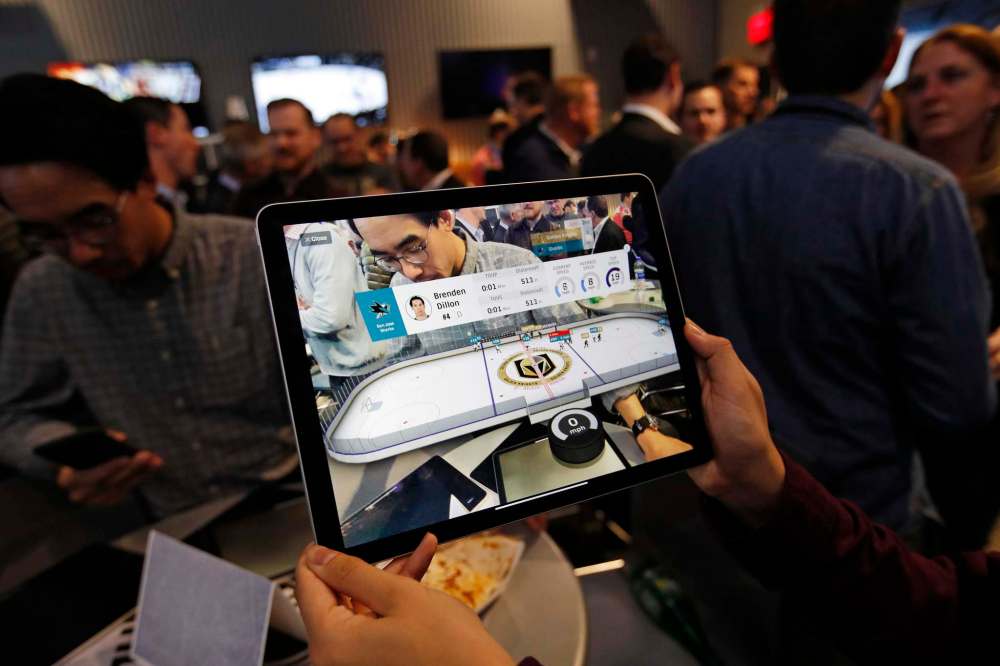Get ready for a game-changer NHL puck and player tracking technology promises to revolutionize the sport
Read this article for free:
or
Already have an account? Log in here »
To continue reading, please subscribe:
Monthly Digital Subscription
$0 for the first 4 weeks*
- Enjoy unlimited reading on winnipegfreepress.com
- Read the E-Edition, our digital replica newspaper
- Access News Break, our award-winning app
- Play interactive puzzles
*No charge for 4 weeks then price increases to the regular rate of $19.00 plus GST every four weeks. Offer available to new and qualified returning subscribers only. Cancel any time.
Monthly Digital Subscription
$4.75/week*
- Enjoy unlimited reading on winnipegfreepress.com
- Read the E-Edition, our digital replica newspaper
- Access News Break, our award-winning app
- Play interactive puzzles
*Billed as $19 plus GST every four weeks. Cancel any time.
To continue reading, please subscribe:
Add Free Press access to your Brandon Sun subscription for only an additional
$1 for the first 4 weeks*
*Your next subscription payment will increase by $1.00 and you will be charged $16.99 plus GST for four weeks. After four weeks, your payment will increase to $23.99 plus GST every four weeks.
Read unlimited articles for free today:
or
Already have an account? Log in here »
Hey there, time traveller!
This article was published 23/09/2020 (1907 days ago), so information in it may no longer be current.
EDMONTON — Brace yourselves for change, folks. Hockey as you know it is about to undergo an extreme makeover.
It’s not really visible to the naked eye, but a tiny bump on the shoulder pads of every player competing in the Stanley Cup final in Edmonton is a sign of what’s to come. Members of the Tampa Bay Lightning and Dallas Stars are being used as guinea pigs for NHL puck and player tracking technology, which is expected to become the new normal by the 2020-21 season.
Ever wondered just how fast Nikolaj Ehlers was skating when he made that unreal zone entry? The velocity of Patrik Laine’s one-timer on the power play? How many miles of ice Mark Scheifele covered in a game? The probability of Connor Hellebuyck making the circus-like save? How effective, or not, the Winnipeg Jets defencemen are at closing the gap on opposing forwards.?
All of that information, and much, much more, will soon be available for public consumption.

“With this tracking data, now you can say a player could intercept that pass or couldn’t intercept that pass, now you can say who was in the lane, who was supposed to be in the lane, who’s out of position, what kind of gap control there was, how close is the closest defender to putting on pressure. You will have all that data for all 10 (skaters) on the ice,” said Andrew Berkshire, a Canadian-based hockey analytics expert who writes on the subject for several publications, including the Free Press.
“And the same with goalies. You can say on a shot whether the goaltender’s arm was too high or too low. What’s their usual posture for handling such a shot with the body location data? There’s all sorts of things that can go into it.”
In addition to the sensor placed on the shoulder pads of every player, which clocks their movements 200 times per second, there’s also a similar device inside specially manufactured pucks that have are now being used. Rogers Place has more than a dozen antennae installed in the rafters, while four cameras are being used for tracking.
Skating and shot speed, location and distance, player and puck positioning, time on ice, zone time, shift length, save percentage by distance, goaltender location and positioning zone entries and exits and team puck possession times are among the focal points in the NHL’s partnership with software giant SAP.
“From a broadcast standpoint, we’re probably a couple years away from it being used effectively. Things like how fast was a shot, how far did he skate, that’s interesting anecdotal stuff, but I think in terms of understanding the intricacies of the game it doesn’t give a lot to the viewer.” – Andrew Berkshire
The NHL began looking at this technology in 2013 and has invested tens of millions of dollars in getting it right, with previous testing at recent all-star games that sent them back to the drawing board for tweaks. Getting the perfect puck was the biggest challenge, with testing now showing it can withstand an impact of up to 170 miles per hour without damage to the sensor.
The league originally planned to roll it out late in the 2019-20 season, with most arenas already outfitted with the technology, but the COVID-19 pandemic pushed that back. Although it wasn’t used for the early rounds of the playoffs in the hub cities of Edmonton and Toronto, it is now ready to go and being utilized in the Cup final with the idea of a complete unveiling next season, whenever that might be.
The information being collected is not yet publicly available. Right now, it’s being shared with Sportsnet and NBC, which have sprinkled a few tidbits into their broadcasts. You may have seen the few occasions when they go to a wide shot of the rink, where the names of all 12 players on the ice at a time fill your screen.
“From a broadcast standpoint, we’re probably a couple years away from it being used effectively. Things like how fast was a shot, how far did he skate, that’s interesting anecdotal stuff, but I think in terms of understanding the intricacies of the game it doesn’t give a lot to the viewer,” said Berkshire.

That will eventually expand into more bells and whistles, which viewers will likely be able to adjust for their own preferences. The NHL’s plan is to eventually make feeds available, either on television and/or mobile devices, where fans — especially those who skew younger — could pick a dedicated stream that shows puck and player data in real time.
“Being on the forefront of innovation is good for our game, and most especially our fans,” NHL commissioner Gary Bettman said earlier this year. “If you’re a millennial or a Gen Z in particular and you’re consuming sports differently than it’s ever been consumed before, we’re going to be right there for you giving you what you want.”
Coaches will find this to be a valuable weapon for game-planning, and it could also lead to some significant changes within hockey operations departments.
“The biggest difficulty is going to be the sheer volume of it,” said Berkshire. “A lot of teams when they see the raw data (already available), it’s just overwhelming. This is going to be a whole new level of overwhelming. You’re going to need data scientists to dig in and find out what’s important and what’s not important.”
“Especially if there’s live betting situations. That would be super interesting to see how much that can transfer through.” – Andrew Berkshire
NHL clubs and analysts have largely relied on analytical data, which Berkshire said is exclusively about “puck touches, who’s getting the puck, who’s doing something with it.” Now, the new tracking will allow for widespread collection of what he calls “passive data” — as in, what is everyone else on the ice doing when they don’t have the puck?
Get ready for it to be used in future contract negotiations, especially ones that go to salary arbitration where the team and player/agent can’t agree on a price.
“If the player agency puts in the work to get something out of it, I think arbitration will be something teams are a little more afraid of,” said Berkshire. Of course, it could also work in reverse, with a club using data to shred a player.
Finally, the NHL has alluded to making inroads in the world of sports gambling, and this is a tool that could be used in that regard as well.
“Especially if there’s live betting situations. That would be super interesting to see how much that can transfer through,” said Berkshire.
Of course, for those who just want to keep watching and breaking down hockey the old-fashioned way, that option will still exist. But there’s no question the NHL is on the cusp of something pretty exciting and innovative here.
mike.mcintyre@freepress.mb.ca
Twitter: @mikemcintyrewpg

Mike McIntyre grew up wanting to be a professional wrestler. But when that dream fizzled, he put all his brawn into becoming a professional writer.
Our newsroom depends on a growing audience of readers to power our journalism. If you are not a paid reader, please consider becoming a subscriber.
Our newsroom depends on its audience of readers to power our journalism. Thank you for your support.







